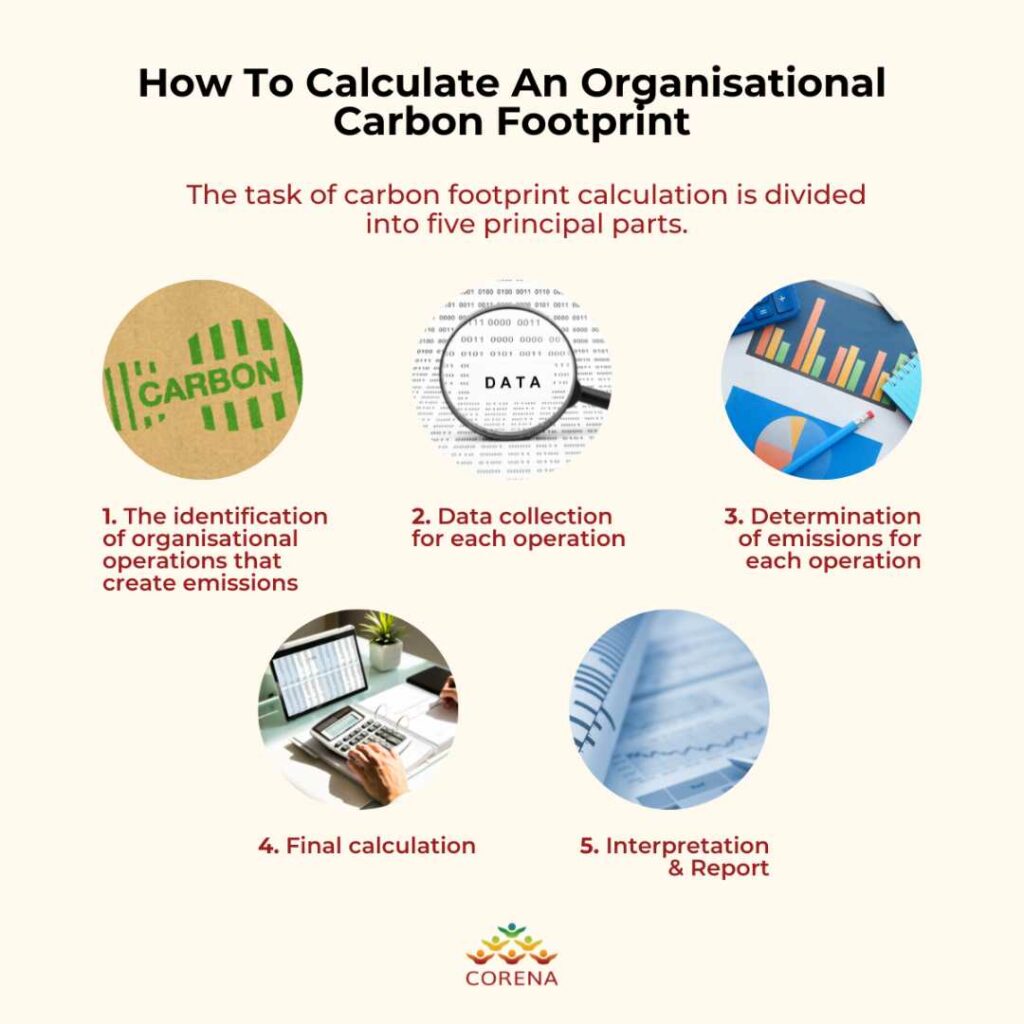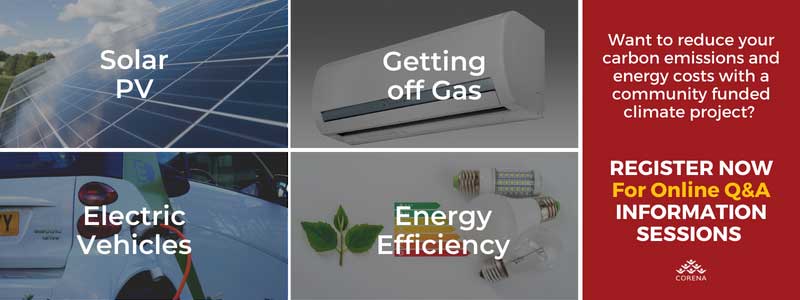Just like individuals, every organisation, whether private or public, for-profit or non-profit has a carbon footprint. An organisational carbon footprint is usually defined as the quantity of emissions of carbon dioxide (CO2) that can be related to the activities of that organisation. The carbon footprint is often extended to emissions of other greenhouse gases – nitrous oxide, methane, or chlorofluorocarbons (CFCs).
Thanks to increasing consciousness, the community wish to see meaningful action to counteract the climate emergency and other negative environmental impacts.
Carbon footprint calculations are an essential part of all organisations’ environmental, social, and governance (ESG) strategies.
The first stage in minimising your organisational carbon footprint is to start measuring it. To help we’ve put together this guide to help you calculate your organisation’s carbon footprint.

What Is A Carbon Footprint & How Does It Relate To Organisations?
The carbon footprint of an organisation is the measurement of its greenhouse gas (GHG) emissions in tonnes.
Greenhouse gases are released into the atmosphere by an organisation carrying out its core activities and their associated energy use. When calculating an organisation’s carbon footprint, the direct and indirect emissions have to be taken into account.
You may wonder what these are, so here are some brief examples:
- Direct GHG emission results from organisation activities. For example, if a food bank releases carbon dioxide (CO2) while using gas to heat food then this would be a direct GHG emission, as is vehicle exhaust while delivering groceries to the homeless.
- The activity of other organisations producing the fuel, power, and other necessities is an important part of the carbon footprint. The production and transportation involved in these produce GHG. Examples are the electricity used by the organisation or the waste it produces.
An initiative called the Greenhouse Gas Protocol of the World Resources Institute and World Business Council for Sustainable Development puts greenhouse gas emissions into three groups called Scopes. This protocol is what the methods for calculating your organisation\’s carbon footprint are based on.
Scope 1 emissions are direct GHG emissions, Scope 2 emissions are the part of indirect GHG emissions caused by an organisation’s electricity use. Scope 3 emissions are another part of indirect GHG emissions that come from upstream and downstream activities.
In Australia, carbon emissions are calculated using processes set under the National Greenhouse Emissions Reporting Scheme (NGERS). All organisations emitting 25,000 tonnes of CO2 equivalent or more must report their carbon emissions under this scheme. Most non-profits (unless very large) are unlikely to trigger this threshold but the same carbon accounting methods can be used voluntarily for your own internal reporting purposes.
If your business or organisation is small or medium you can gather the data in-house and use a tool such as Climate Clever to calculate your footprint. However if you have someone who is good with spreadsheets and calculations they may be confident to give it a go themselves. CORENA is happy to help out with this if you need advice.
For large organisations gathering this data is a big task and you may well need external assistance for an accurate calculation of the carbon footprint. There are a number of consultants that provide these services in Australia.
How To Calculate An Organisational Carbon Footprint
The task of carbon footprint calculation is divided into five principal parts, which are:
1. The identification of organisational operations that create emissions
Every organisational operation that emits GHG must be identified. Obvious examples are electricity use and transportation of goods and services. For most non profits the major sources of greenhouse gas emissions will be electricity use, gas use, and fuel use.
2. Data collection for each operation
For each activity, collect your electricity, gas and fuel bills to work out the amount you have used in a year. You will need your annual electricity use in kWhs (or units), your annual fuel use in litres and your annual gas use in GJ.
Gas and fuel use are Scope 1 emissions, electricity use is Scope 2, and waste, scope 3. To start with, many organisations focus on their Scope 1 and 2 emissions and that is what is included in this guide. However Scope 3 emissions like waste are also very important and you may like to expand your carbon footprint down the track to include these.
3. Determination of emissions for each operation
In Step 1, GHG emitting processes were identified, and in Step 2, data was collected. Now you are in a position to start using this raw data to determine the emissions of your organisation.
For electricity, the emission factors vary by state (depending on how that state generates its electricity) and are slowly going down each year as more and more renewables enter the grid. States like Tasmania and South Australia have very low emissions factors because they have a lot of renewables in their grid.
To calculate the carbon footprint of your electricity use, you multiply the number of annual kilowatt hours in your power bills by the emission factor for your state to get kilograms of CO2.
| State, Territory or grid description | Emission Factors kg CO2/kWh |
| New South Wales and Australian Capital Territory | 0.79 |
| Victoria | 0.92 |
| Queensland | 0.88 |
| South Australia | 0.33 |
| Western Australia -South West Interconnected System (SWIS) | 0.55 |
| Tasmania | 0.18 |
| Northern territory -Darwin Katherine Interconnected System (DKIS) | 0.61 |
| Western Australia – North Western Interconnected System (NWIS) | 0.58 |
| National | 0.77 |
For fuel you would normally have data in litres (or kilolitres which is just a thousand litres). Multiply the litres by the emissions factor below to get the kilograms of CO2.
| Fuel litres (cars and light vehicles – not trucks) | Emissions factor kg CO2/litre |
| Automotive gasoline/petrol | 2.9 |
| Diesel | 3.38 |
Gas is unfortunately a bit more complicated! For gas your bill might be in one of a couple of different units but it is normally MJ or cubic metres. To make it even trickier, in WA, usage is measured in “units”. A unit of gas is equivalent to 1 kWh of energy. The emissions vary by state and whether they are delivered to a metro or non metro location. This is because the ways in which gas is extracted, produced and transported vary depending on where it comes from. You can find the factors on page 14 of the National Greenhouse Account Factors 2022 but if you would like to calculate your gas emissions contact us and we will help you out.
4. Final calculation
Gathering all the individual calculations from 3 leads to the final calculation. The different calculations performed in step 3 produced the GHG for each operation of the enterprise. Now all these are added to give a final estimate of the total GHG emitted.
Once you have done that you can use the data to work out what your main emissions sources are and focus your efforts there. Graphs such as the below examples are useful for targeting your actions and internal reporting on your progress.
So for example these graphs could be for a school. They can see that the majority of their carbon emissions come from the electricity use for heating and cooling, lighting and IT. This is followed by gas which is used for water heating and cooking at an onsite educational kitchen. Fuel emissions come from two school buses. They can see here that the majority of their effort should initially be aimed at their electricity use as it makes up the majority of their carbon emissions.
The second graph shows carbon emissions over a period of 4 years. They have installed a large solar system and addressed inefficiency in their heating and cooling systems which has meant that their carbon emissions have fallen over time. They can use this graph to present to their school board to show how their efforts have been successful and argue for further action.
5. Interpretation & Report
The final step in the calculation of your enterprise’s carbon footprint is to interpret and report on it. In so doing, you can determine and specify those activities that are the biggest GHG emitters. Once identified, you can develop strategies of mitigation, which you should inform stakeholders, such as clients, donors, and investors about.
Calculating your carbon footprint is the first step in going carbon neutral under the Climate Active Standard. There are rules about the level of data collection you need to complete and claiming you are carbon neutral so it is worth getting specialised advice if you intend to do this.
How CORENA Can Help You Reduce Your Carbon Footprint
CORENA, can provide free technical advice and zero interest funding to not for profits, charities, community organisations and social enterprises looking to reduce their emissions and green their energy consumption. We are funded by donations from local community members across Australia. Donations help us fund:
- Solar Panels
- Installing energy efficiency measures such as switching to efficient alternatives or installing insulation
- Getting Off Gas – Replacement of fossil gas appliances with electric alternatives
- Electric Vehicles
- A combination of the above
Learn more in 5 Ways CORENA Helps Non Profits Reduce Carbon Emissions & Energy Costs


